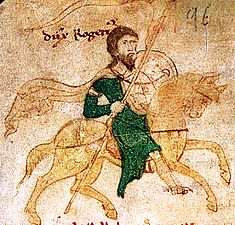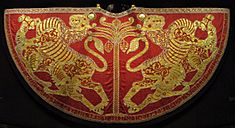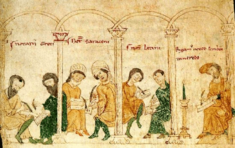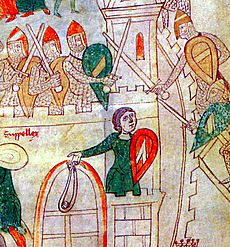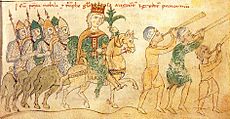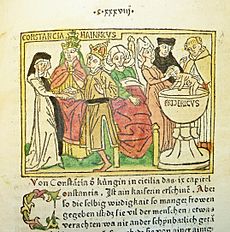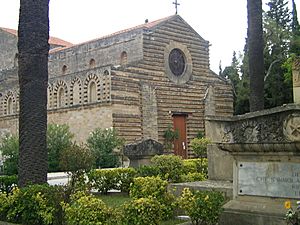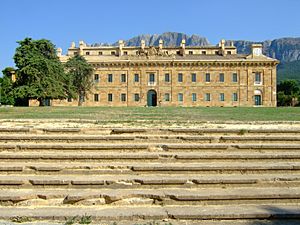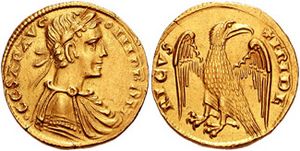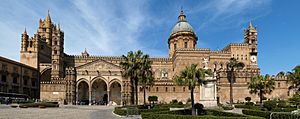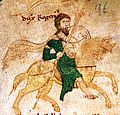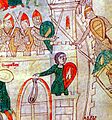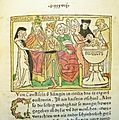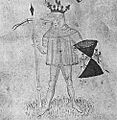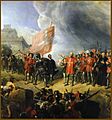Kingdom of Sicily facts for kids
Quick facts for kids
Kingdom of Sicily
|
|||||||||||||||
|---|---|---|---|---|---|---|---|---|---|---|---|---|---|---|---|
| 1130–1816 | |||||||||||||||
|
Motto: Animus Tuus Dominus
"Your heart is yours" |
|||||||||||||||
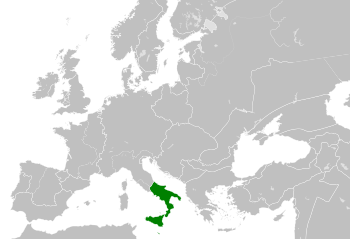
The Kingdom of Sicily in 1190.
|
|||||||||||||||
| Status | Sovereign state (1130–1412, 1806–1816) Part of the Crown of Aragon (1412–1516) Direct Spanish rule (1516–1713) Personal union with the Duchy of Savoy (1713–1720) Under Habsburg rule (1720–1735) Personal union with the Kingdom of Naples (1735–1806) |
||||||||||||||
| Capital | Palermo | ||||||||||||||
| Official languages | |||||||||||||||
| Religion |
|
||||||||||||||
| Demonym(s) | Sicilian | ||||||||||||||
| Government | Feudal monarchy | ||||||||||||||
| King | |||||||||||||||
|
• 1130–1154
|
Roger II (first) | ||||||||||||||
|
• 1266–1282
|
Charles I of Anjou | ||||||||||||||
|
• 1759–1816
|
Ferdinand III (last) | ||||||||||||||
| Legislature | Parliament | ||||||||||||||
| History | |||||||||||||||
| 1130 | |||||||||||||||
| 1282 | |||||||||||||||
| 1816 | |||||||||||||||
|
|||||||||||||||
| Today part of | Italy Malta |
||||||||||||||
The Kingdom of Sicily (Latin: Regnum Siciliae; Italian: Regno di Sicilia; Sicilian: Regnu di Sicilia) was a powerful state in southern Italy. It also controlled parts of North Africa for a while. It was founded in 1130 by Roger II of Sicily and lasted until 1816.
This kingdom grew out of the County of Sicily, which was created in 1071. This happened during the Norman conquest of southern Italy, when Normans took control of the area. The island of Sicily was split into three main regions: Val di Mazara, Val Demone, and Val di Noto.
In 1282, a big revolt called the Sicilian Vespers happened. People on the island of Sicily rebelled against their French rulers. This led to the kingdom splitting into two parts. The island of Sicily became a separate kingdom, ruled by the Spanish Crown of Aragon. The mainland part, with its capital in Naples, became known as the Kingdom of Naples.
In 1816, the island Kingdom of Sicily and the Kingdom of Naples joined together again. They formed the Kingdom of the Two Sicilies.
Contents
History of the Kingdom of Sicily
Norman Rule Begins
By the 11th century, Norman fighters were hired by different powers in southern Italy. These Normans were descendants of Vikings from northern France. It was the Normans, led by Roger I of Sicily, who conquered Sicily. They took it from the Muslim rulers there.
After taking other areas like Apulia and Calabria, Roger I captured Messina with 700 knights. In 1068, Roger I and his army defeated the Muslims at Misilmeri. The most important battle was the Siege of Palermo. This battle led to Sicily being fully under Norman control by 1091.
The Norman Kingdom
The Norman Kingdom was officially created on Christmas Day, 1130. Roger II of Sicily became the first king with the approval of Pope Innocent II. Roger II brought together all the lands he had inherited. These included the Maltese Archipelago, which was taken from Arab rulers. He also added the Duchy of Apulia and the County of Sicily.
Roger II wanted to make the government stronger and more organized. He created new laws, like the Assizes of Ariano. His admiral, George of Antioch, helped him conquer parts of North Africa. This made Sicily a major sea power in the Mediterranean Sea for almost 100 years.
Roger's son, William I of Sicily, became king after him. He was known as "William the Bad" because he was not popular with writers of the time. He had to put down several rebellions by powerful nobles. William I lost most of Sicily's African lands. He died in 1166.
His son, William II of Sicily, became king when he was still a child. His mother, Margaret of Navarre, ruled for him until 1172. William II's time as king was mostly peaceful and prosperous. He was called "the Good." However, he had no children, which caused problems for who would rule next.
William II's aunt, Constance of Sicily, was the only remaining heir. She was married to Henry VI, Holy Roman Emperor. William II named Constance and Henry as his heirs. But many officials did not want a German ruler. When William died in 1189, the kingdom faced a crisis.
Tancred of Lecce took the throne with support from officials. But Henry VI invaded Sicily on behalf of his wife, Constance. Henry had to retreat at first. Tancred died in 1194. Constance and Henry then took control. The kingdom came under the rule of the House of Hohenstaufen.
Hohenstaufen Rule
In 1197, Frederick, who was a child, became king. He would later become the Holy Roman Emperor. His young age caused a power struggle in Sicily. The Pope tried to gain more control over Sicily.
Frederick I continued to reform the laws. He issued the Constitutions of Melfi in 1231. These laws aimed to create a strong, central government. For example, people could not carry weapons in public unless ordered by the king. This helped reduce rebellions. The Constitutions made the Kingdom of Sicily an absolute monarchy. This was the first centralized state in Europe to move away from feudalism. These laws were used in Sicily until 1819. Frederick also built the Castel del Monte and founded the University of Naples.
After Frederick's death, his son Conrad IV of Germany ruled. Then, Frederick's illegitimate son, Manfred of Sicily, took power. He ruled for 15 years. The Pope declared that the Hohenstaufen family had lost their right to rule. The Pope then made a deal with Louis IX of France. Louis's brother, Charles I of Anjou, would become king of Sicily. Charles agreed to recognize the Pope's authority and pay tribute.
The Hohenstaufen rule ended after Charles of Anjou invaded in 1266. Conradin, the last male heir of the Hohenstaufen family, died in 1268.
French Rule and the Split
In 1266, Charles I of Anjou conquered Sicily. People were unhappy with French officials and high taxes. Agents from Spain and the Byzantine Empire encouraged rebellion. This led to the successful revolt of the Sicilian Vespers in 1282. After the revolt, King Peter III of Aragon was invited to intervene.
The resulting War of the Sicilian Vespers lasted until 1302. It officially split the old Kingdom of Sicily into two parts. The island of Sicily went to Frederick III of Sicily of the House of Barcelona. The mainland part, called the Kingdom of Naples, went to Charles II of Naples of the Capetian House of Anjou. This split became permanent in 1372. Even when the same king ruled both in the 16th century, their governments remained separate. They were finally reunited in 1816 as the Kingdom of Two Sicilies.
Sicily Under Spain
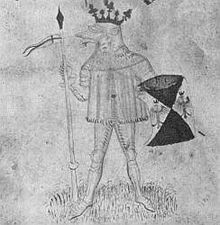
Sicily was ruled as an independent kingdom by relatives of the Spanish House of Aragon until 1409. After that, it became a part of the Crown of Aragon. The Kingdom of Naples was ruled by the French until Alfonso V of Aragon reunited the two thrones in 1443.
Alfonso later divided the two kingdoms again. He gave Naples to his son, Ferdinand I of Naples. He gave the rest of the Crown of Aragon and Sicily to his brother. From 1494 to 1503, French kings tried to conquer Naples but failed. Eventually, the Kingdom of Naples was reunited with the Crown of Aragon. Spanish kings ruled both until 1700.
Malta and the Knights
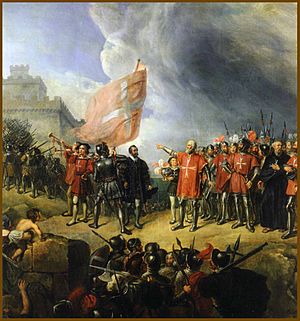
In 1530, Charles V, Holy Roman Emperor gave the islands of Malta and Gozo to the Knights Hospitaller. This was to protect Rome from Ottoman attacks. The Knights paid a small annual fee of two Maltese falcons to the Viceroy of Sicily. Malta had been part of Sicily since 1091. This connection continued until the French took Malta in 1798.
After the Maltese rebelled against the French, Malta came under British protection. It became a British colony in 1813. This was made official by the Treaty of Paris (1814) in 1814. This treaty ended Malta's 700-year link with Sicily.
Changes in Rulers (1713-1735)
From 1713 to 1720, the House of Savoy briefly ruled the Kingdom of Sicily. They received it as a reward after the War of the Spanish Succession. The new king, Victor Amadeus II, visited Sicily in 1713.
In 1718, Spain occupied Sicily. It became clear that Savoy could not defend Sicily. So, Austria traded its Kingdom of Sardinia for Sicily. Victor Amadeus protested because Sicily was much richer. But he could not stop the exchange. Spain was defeated in 1720. The Treaty of The Hague (1720) confirmed that Sicily now belonged to the Austrian Habsburgs.
The Bourbon Kings
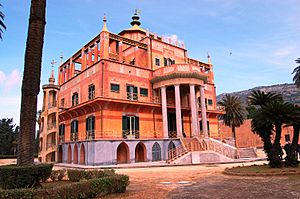
In 1734, during the War of the Polish Succession, Spain reconquered Naples. King Philip V of Spain made his son, Charles, King Charles VII of Naples. The next year, Charles also became King of Sicily (as Charles V). Austria gave up Sicily and its claims to Naples.
This change brought a time of economic growth and reforms. Many public projects and cultural activities began. Charles remained King of Sicily until he became King of Spain in 1759. A treaty prevented him from uniting his Italian lands with Spain.
Charles III gave the thrones to his third son, Ferdinand. Ferdinand became Ferdinand IV of Naples and III of Sicily. He was young, so others held the real power. During this time, many reforms stopped. The king was often not interested in state matters. His wife, Queen Maria Carolina, and prime ministers ran the government. They tried to move Naples and Sicily away from Spanish and Austrian influence. They wanted closer ties with Great Britain. This period saw many European thinkers visit Sicily. They spread ideas from the Age of Enlightenment and made Sicily's beauty famous.
In 1799, Napoleon conquered Naples. King Ferdinand and his court fled to Sicily. They were protected by the British fleet, led by Horatio Nelson. Sicily became a British base against Napoleon. Under British guidance, especially from Lord William Bentinck, Sicily tried to modernize its government. The king was forced to approve a constitution like the British system. This new system created a two-chamber parliament. It also ended feudalism in the kingdom. The island was under British control from 1806 to 1814.
After Napoleon's defeat in 1815, Ferdinand canceled all reforms. He even removed the Kingdom of Sicily from the map. He created the new Kingdom of the Two Sicilies in 1816, with Naples as its capital. The people of Sicily rebelled against this. They felt it broke their old laws. But they were defeated by forces from Naples and Austria in 1820.
Another Sicilian revolution happened in 1848–49. It was put down by the new king, Ferdinand II of the Two Sicilies. He was called Re Bomba (King Bomb) after he bombed Messina for five days. The growing anger of Sicilians towards Naples and the Bourbon family created an unstable situation. It was only controlled by a harsh police state, political executions, and exiles.
Society and People
During the Norman Kingdom of Sicily, local communities kept their special rights. Later, under the Hohenstaufen rulers, local nobles were replaced by lords from northern Italy. This caused conflicts and rebellions in many cities. These revolts led to the destruction of farming areas. They also led to city dwellers supporting the Crown of Aragon. This situation continued under the French rulers until the Sicilian Vespers revolt. The French rulers also increased the power of the nobility.
The system of feudalism became stronger in Sicily. The 1669 Etna eruption destroyed Catania. In 1693, earthquakes killed 5% of the kingdom's population. There were also outbreaks of plague. The 17th and 18th centuries were a time of decline for the kingdom. Corruption was common among the upper and middle classes. Bad treatment of the lower classes by feudal lords led to groups of bandits. These groups, who called themselves "mafia," were the start of the modern Sicilian Mafia. The many revolts against the monarchy eventually led to Sicily joining Italy.
The kingdom had a parliament from 1097. This parliament met throughout the kingdom's history until 1812.
Population of Sicily
During the reign of Frederick II (1198-1250), about 2.5 million people lived in the kingdom. Three towns had populations over 20,000. After the loss of the northern areas in 1282 and natural disasters, the population of Sicily decreased. In 1803, the kingdom's population was 1,656,000. The main cities were Palermo, Catania, Messina, Modica, and Syracuse.
| Division | Population |
|---|---|
| Val di Mazzara | 643,000 |
| Val di Demona | 521,000 |
| Val di Noto | 459,000 |
| Lipari Islands | 18,000 |
| Aegadian Islands | 12,000 |
| Pantelleria Island | 3,000 |
| Total Population | 1,656,000 |
| City | Population |
|---|---|
| Palermo | 120,000 |
| Catania | 40,000 |
| Messina | 36,000 |
| Modica | 23,500 |
| Syracuse | 17,000 |
Economy and Trade
The land in Sicily was very fertile. Norman kings brought settlers to farm areas that needed it. This helped increase farm production. The main source of wealth for the Kingdom of Sicily came from its port cities. The most important were Naples and Amalfi. From these cities, local products were sent out.
The main export was durum wheat. Other exports included nuts, timber, oil, bacon, cheese, furs, hides, hemp, and cloth. By the late 12th century, Messina became one of the kingdom's top trading cities.
Sicily's products went to many different lands. These included Genoa, Pisa, the Byzantine Empire, and Egypt. Over time, this trade relationship became less helpful for Sicily. Some modern experts believe Sicily's economy declined in the Late Middle Ages.
The feudal system under French rule reduced the king's wealth. The French rulers relied on trade with northern Italy and loans from bankers in Florence. These were major reasons for the kingdom's economic decline. The continued economic decline, along with more people and cities, led to less farm production.
By 1800, one-third of the crops were grown using old methods. This made the problem worse. In the later Spanish rule, the trading system was also not good. This was because of high taxes on exports and companies that controlled prices.
Money Used
The Norman kings in the 12th century used the tari. This coin had been used in Sicily since 913. One tari weighed about one gram and was made of 16 1/3 carats of gold. The Arab dinar was worth four tari. The Byzantine solidus was worth six tari. In the kingdom, one onza was equal to 30 tari. One tari was worth 20 grani.
After defeating the Tunisians in 1231, King Frederick I minted the augustalis. It was made of 21 1/2 carats of gold and weighed 5.28 grams. In 1490, the triumphi coins were minted in Sicily. They were similar to the Venetian ducat.
Religion in Sicily
During the Norman rule, different religious groups lived together in Sicily. These included Latin Catholics (Roman Catholics), Greek-rite Catholics (Greek Catholic), Muslims, and Jews. Latin Catholicism was favored because Latin Catholics were in power. Greek-rite bishops had to accept the Latin Church's authority. Muslim communities were no longer ruled by their local leaders.
Greek-speaking Christians, Latin Christians, and Muslims often interacted. They were involved in each other's lives in many ways. Some even married each other. Catholics in Arabic-speaking areas might use Arabic names. In many cities, each religious group had its own rules and courts. In Palermo, Muslims could publicly call for prayer. Their legal issues were handled by qadis, who judged based on Islamic law. Since the 12th century, Christianity was the official religion of the Kingdom of Sicily.
After the Hohenstaufen family took power, Latin and Greek Catholics kept their rights. But Muslims faced more hardship. Italian settlers from northern Italy wanted Muslim property. This led many Muslim communities to rebel or move to mountainous areas. These revolts led to violence. Eventually, the entire Muslim population was moved to Lucera in Apulia and Girifalco in Calabria. There, they paid taxes and worked as farmers, craftsmen, and soldiers for the king. The Muslim community in Lucera was finally broken up in 1300. Many of its people were sold into slavery. The Jewish community was expelled from Sicily between 1493 and 1513. This happened after the Spanish Inquisition was set up. The remaining Jews slowly became part of the Christian population. Most converted to Roman Catholicism.
Images for kids
-
Roger II, the first King of Sicily.
-
Woodcut illustration of Constance of Sicily, her husband Emperor Henry VI and her son Frederick II
-
Martin I, King of Sicily in 1390–1409.
-
Philippe de Villiers de l'Isle Adam takes possession of the island of Malta, 26 October 1530 by René Théodore Berthon.
-
La Palazzina Cinese di Palermo, built by Ferdinand III of Sicily
See also
 In Spanish: Reino de Sicilia para niños
In Spanish: Reino de Sicilia para niños
- Angelo da Furci
- County palatine of Cephalonia and Zakynthos
- Emirate of Sicily
- Expedition of the Thousand
- Expulsion of the Jews from Sicily
- Kingdom of Naples
- Kingdom of the Two Sicilies
- Kingdom of Sicily under Savoy
- List of Sicilian monarchs
- Norman–Arab–Byzantine culture
- Norman conquest of southern Italy
- Redshirts
- Sicilian Parliament
- War of the Sicilian Vespers




